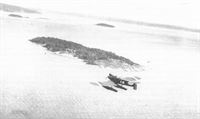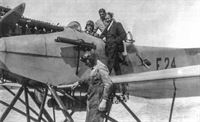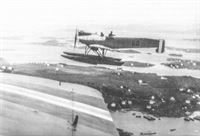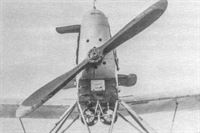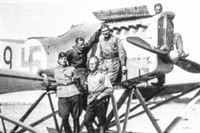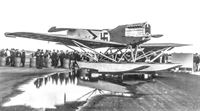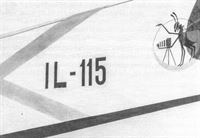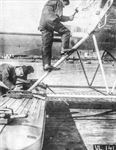
Описание
Страна: Германия
Год: 1918
Варианты
- Hansa-Brandenburg - W.29 - 1918 - Германия
- Hansa-Brandenburg - W.33 / W.34 / W.37 - 1918 - Германия
- Caspar - S.1 - 1922 - Германия
- В.Обухович, А.Никифоров Самолеты Первой Мировой войны
- O.Thetford, P.Gray German Aircraft of the First World War (Putnam)
- W.Green, G.Swanborough The Complete Book of Fighters
- J.Herris Development of German Warplanes in WWI (A Centennial Perspective on Great War Airplanes 1)
- J.Herris German Seaplane Fighters of WWI (A Centennial Perspective on Great War Airplanes 2)
- C.Owers Hansa-Brandenburg Aircraft of WWI Vol.3: Monoplane Seaplanes (A Centennial Perspective on Great War Airplanes 19)
- M.Dusing German Aviation Industry in WWI. Volume 1 (A Centennial Perspective on Great War Airplanes 84)
-
C.Owers - Hansa-Brandenburg Aircraft of WWI. Volume 3 - Monoplane Seaplanes /Centennial Perspective/ (19)
W.33 Marine Number 2538, one of the first three W.33 prototypes, Warnemunde, August 1918.
-
C.Owers - Hansa-Brandenburg Aircraft of WWI. Volume 3 - Monoplane Seaplanes /Centennial Perspective/ (19)
W.33 F.24 of the Norwegian Naval Air Service, 1920s. Built in 1923, F.24 II survived until 1935.
-
C.Owers - Hansa-Brandenburg Aircraft of WWI. Volume 3 - Monoplane Seaplanes /Centennial Perspective/ (19)
W.33 N.47 of the Norwegian Postal Service, Horten, August-November 1931.
-
C.Owers - Hansa-Brandenburg Aircraft of WWI. Volume 3 - Monoplane Seaplanes /Centennial Perspective/ (19)
W.33 F.20 of the Norwegian Air Service.
-
C.Owers - Hansa-Brandenburg Aircraft of WWI. Volume 3 - Monoplane Seaplanes /Centennial Perspective/ (19)
W.33 F.50 of the Norwegian Naval Air Service, 1928. F.50 II was one of six W.33s built by the Royal Norwegian Army Aircraft Factory at Kjellor. Originally serial 521, it was renumbered E50 II when transferred to the Navy in 1928.
-
C.Owers - Hansa-Brandenburg Aircraft of WWI. Volume 3 - Monoplane Seaplanes /Centennial Perspective/ (19)
I.V.L. A.22 of the Finnish Air Service, summer 1923.
-
C.Owers - Hansa-Brandenburg Aircraft of WWI. Volume 3 - Monoplane Seaplanes /Centennial Perspective/ (19)
I.V.L. A.22 4.E16, Finnish Air Service, ca. 1925-26.
-
C.Owers - Hansa-Brandenburg Aircraft of WWI. Volume 3 - Monoplane Seaplanes /Centennial Perspective/ (19)
I.V.L. A.22 4.F.52, CO, Santahanina Aviation School, Finnish Air Service, Summer 1925. The overall dark color is shown here as red.
-
W.Green, G.Swanborough - The Complete Book of Fighters
Skis could replace the regular floats of the W 33, as seen on this Finnish-built example flown by No 1 Detached Maritime Flying Squadron.
-
C.Owers - Hansa-Brandenburg Aircraft of WWI. Volume 3 - Monoplane Seaplanes /Centennial Perspective/ (19)
I.V.L. A.22 IL-93 of the Marine Aviation Sqdn., Finnish Air Service.
-
C.Owers - Hansa-Brandenburg Aircraft of WWI. Volume 3 - Monoplane Seaplanes /Centennial Perspective/ (19)
I.V.L. A.22 IL-97 of the Finnish Air Service, 1920s.
-
C.Owers - Hansa-Brandenburg Aircraft of WWI. Volume 3 - Monoplane Seaplanes /Centennial Perspective/ (19)
I.V.L. A.22 IL-115, Santahanina Aviation School, Finnish Air Service. 1929.
-
C.Owers - Hansa-Brandenburg Aircraft of WWI. Volume 3 - Monoplane Seaplanes /Centennial Perspective/ (19)
I.V.L. A.22 IL-119 of the 1st Detached Maritime Sqdn., Finnish Air Service, February 1930.
-
C.Owers - Hansa-Brandenburg Aircraft of WWI. Volume 3 - Monoplane Seaplanes /Centennial Perspective/ (19)
I.V.L. A.22 4G100, Latvian Air Service, 1926-1927
-
J.Herris - German Seaplane Fighters of WWI /Centennial Perspective/ (2)
The W33 was known as the IVL A.22 in Finnish service, this example survives in the Finnish aviation museum.
-
C.Owers - Hansa-Brandenburg Aircraft of WWI. Volume 3 - Monoplane Seaplanes /Centennial Perspective/ (19)
IL.2 on the occasion of its public showing at the international air show at Helsinki airport in September 1969 after its restoration. First flown on Armistice Day 1922 as 4D.2, it was delivered to the air arm of the Finnish Army on 1 December. A forced landing in afield on 3 July 1927, caused much damage as the aircraft was fitted with pontoons at the time. Returned to IVL for repair, it ended up stored at Vesivehmaa airforce base for many years together with other veteran aircraft including an Avro 504K, Rumpler 6B1, and Martinsyde F.4, before being transferred to Finnair's Aviation College at Helsinki airport where it was restored by students of the facility during 1967 to 1969. It was displayed at Tampere until the Finnish Aviation Museum was opened.
-
C.Owers - Hansa-Brandenburg Aircraft of WWI. Volume 3 - Monoplane Seaplanes /Centennial Perspective/ (19)
Radiator, engine, and propeller of A22 serial IL.2 on display in the Finnish Aviation Museum.
-
C.Owers - The Fighting America Flying Boats of WWI Vol.2 /Centennial Perspective/ (23)
Despite being a larger aircraft than the W.29, the W.33 is almost indistinguishable from the W.29 in photographs and if the lack of a cut-out at the wing root cannot be seen, then it is necessary to identify the Marine Nummer to be sure that the particular floatplane is indeed a W.33. MN 2538 was ordered as one of the three prototypes on 24 April 1918. This particular machine was in the CK category and was equipped with two fixed, synchronised machine guns for the pilot and a 2 cm Becker cannon for the observer. The engine was the more powerful 260-hp Mercedes D.IVa; other W33s were powered by the 260 hp Maybach Mb.IVa or 275-300 hp BuS.IVa. This photograph was taken at the SVK test center at Warnemunde on 30 August 1918.
The W33 was an enlarged development of the W29 powered by the 260 hp Mercedes D.IVa or similar engines and designed for greater range and endurance. Photographed at Warnemunde on 30 August 1918, this view of W33 Marine #2538 shows the very clean lines of the W33 despite its size. It was finished in the standard late-war naval camouflage. The W33 was the last Brandenburg design to reach combat in WWI but served in Finland for many years after the war. -
M.Dusing - German & Austro-Hungarian Aero Engines of WWI. Vol.3 /Centennial Perspective/ (66)
Front view of Marine #2538, the first Brandenburg W33, shows its streamlined lines. The wing was complex and presented a manufacturing challenge to the Finns when they undertook license production; a lot of technology transfer took place in 1922 between Germany and Finland.
Brandenburg W.33 marine number 2538 was powered by a Maybach Mb IVa. It was the prototype W.33 and is shown here at the SVK test center at Warnemunde on 30 August 1918. -
C.Owers - Hansa-Brandenburg Aircraft of WWI. Volume 3 - Monoplane Seaplanes /Centennial Perspective/ (19)
View of W.33 MN 2538 taken at the SVK test center at Warnemunde on 30 August 1918, emphasize its clean lines for such a large floatplane.
The Brandenburg W.33 seaplane two-seat fighter had a tail design similar to the Phonix C.I for the same reason, to give the gunner a clear field of fire. Clever design integrated bracing of the floats with the wing bracing. The W.33 was an enlarged, more powerful W.29 to increase range and endurance similar to the relationship between the W.12 and W.19. The monoplane design of the W.29 and W.33 was developed to give the fighters greater speed than their biplane counterparts so they could more easily intercept the twin-engine America and Felixstowe flying boats on their antisubmarine patrols. Using engines of similar power, the monoplanes were about 10 mph faster than the biplanes. The W.33 had a successful postwar career in the Baltic countries and was built under license in Norway, Finland, and Latvia and used in these countries. -
J.Herris - German Seaplane Fighters of WWI /Centennial Perspective/ (2)
The W3 3 was an enlarged development of the W29 powered by the 260 hp Mercedes D.IVa or similar engines and designed for greater range and endurance. Photographed at Warnemunde on 30 August 1918, these views of W33 Marine #2538 shows the very clean lines of the W33 despite its size. It was finished in the standard late-war naval camouflage.
-
W.Green, G.Swanborough - The Complete Book of Fighters
Developed from the smaller W 29, the W 33 was built in Norway and Finland after production in Germany was halted by the Armistice.
-
C.Owers - Hansa-Brandenburg Aircraft of WWI. Volume 3 - Monoplane Seaplanes /Centennial Perspective/ (19)
This W.33 has been modified to have a blind flying hood. Note the underslung radiator in front of the front undercarriage struts. F.16 served from 26 May 1923 to 18 November 1933, totalling 925 hours flight time.
-
C.Owers - Hansa-Brandenburg Aircraft of WWI. Volume 3 - Monoplane Seaplanes /Centennial Perspective/ (19)
Two W.33 monoplanes carried the registration F18 and are referred to as F.18 II and F.18 III. By the dark color scheme this machine may be F.18 II.
-
C.Owers - Hansa-Brandenburg Aircraft of WWI. Volume 3 - Monoplane Seaplanes /Centennial Perspective/ (19)
F.18 in flight over typical Norwegian terrain, 1924. F.18 was damaged by a storm in February 1930 while being extensively used in the Antarctic for reconnaissance flights operating from the Norvegia.
-
C.Owers - Hansa-Brandenburg Aircraft of WWI. Volume 3 - Monoplane Seaplanes /Centennial Perspective/ (19)
The W.33 was ideally suited for operations from the protected waters of Norwegian lakes.
-
C.Owers - Hansa-Brandenburg Aircraft of WWI. Volume 3 - Monoplane Seaplanes /Centennial Perspective/ (19)
This group of Norwegian W.33 floatplanes near a slipway display the two color schemes applied to the type. Aircraft 20 displays a pennant to the rear fuselage. Both aircraft have a generator mounted on the side of the observer's cockpit.
-
C.Owers - Hansa-Brandenburg Aircraft of WWI. Volume 3 - Monoplane Seaplanes /Centennial Perspective/ (19)
F.20 II in the dark green finish. This machine has two Lamblin radiators under the fuselage. The metal badge of the Marinens Flyvebaatfabrik can be seen on the fuselage near the footstep under the pilot's cockpit. Delivered on 27 August 1923, this seaplane was used together with F.28 to search for herring along the west coast in November 1929. The operation lasted until the end of December and in January the tow aircraft returned to Horten. In 1930 an enclosed cabin for a radio operator was fitted. F.20 II was written off after a fatal crash in August 1933, the crash leading to the grounding of the Brandenburgs still in service.
-
C.Owers - Hansa-Brandenburg Aircraft of WWI. Volume 3 - Monoplane Seaplanes /Centennial Perspective/ (19)
This floatplane was the third naval W.33 to bear the F.22 registration. Built as a two-seat machine with 260-hp Mercedes engine, it was sent together with N-24 and N-25 to Goteborg in August 1924 when explorer Roald Amundsen's Dornier Wai flying boat went missing during his Arctic expedition.
-
C.Owers - Hansa-Brandenburg Aircraft of WWI. Volume 3 - Monoplane Seaplanes /Centennial Perspective/ (19)
F.22 after an interesting landing. In March 1922 this aircraft brought supplies to four ships stuck in ice in the Kristiania Fjord.
-
C.Owers - Hansa-Brandenburg Aircraft of WWI. Volume 3 - Monoplane Seaplanes /Centennial Perspective/ (19)
F.24 displays the Vickers gun installation, generator at rear cockpit and twin Lamblin radiators under the fuselage.
-
C.Owers - Hansa-Brandenburg Aircraft of WWI. Volume 3 - Monoplane Seaplanes /Centennial Perspective/ (19)
F.24 displays the bomb racks under the fuselage, underslung radiator, and purpose of the long cylinder on the port float is unknown but is considered to be a storage container. F.24 II was built on a contract for four machines at 28,200 Norwegian crowns without motor. In 1924 it was on a trip to Gothenburg. On 28 June 1926 it suffered a crash but was repaired. It suffered a broken wing on alighting in August 1927. The machine was overhauled in the winter of 1928, but required another overhaul in the winter of 1929/1930 after a forced landing due to engine failure on 18 September. 1 January 1934 found the seaplane at Kristiansand with 833 hours logged. It was written off in December 1935.
-
C.Owers - Hansa-Brandenburg Aircraft of WWI. Volume 3 - Monoplane Seaplanes /Centennial Perspective/ (19)
Norwegian Brandenburgs at Horten preparing for warfare exercises, 1924. Most Norwegian W33s used the 260 hp Mercedes D.IVa engine. Armament was a fixed Vickers for the pilot and a flexible Lewis for the observer. The original nose radiators were replaced with a pair of under-wing Lamblin radiators, altering the aircraft's appearance. Note the rail lines leading to the slipway. The tall masts in the background would most probably be for radio transmission.
-
C.Owers - Hansa-Brandenburg Aircraft of WWI. Volume 3 - Monoplane Seaplanes /Centennial Perspective/ (19)
Aircraft 36 displays a pennant to the rear fuselage. F.36 II was ex-Army 519 and a Make III. It was stored and turned over to the Navy at Horten on 4 February 1928. It made flights over the polar ice with Lutzow-Holm. It was completely overhauled in the winter of 1928/1929. It was finally placed into reserve until written off in December 1937.
-
C.Owers - Hansa-Brandenburg Aircraft of WWI. Volume 3 - Monoplane Seaplanes /Centennial Perspective/ (19)
A W.33 in the dark green doped scheme.The numerals "50" may be discerned on the original. F.50 was ex-Army 521.
-
C.Owers - Hansa-Brandenburg Aircraft of WWI. Volume 3 - Monoplane Seaplanes /Centennial Perspective/ (19)
Three W.33 floatplanes at Karljohansvern Marine Flystasjon. F.58 has its Polar Star marking.This is machine c/n 38, the first W.33 to bear the F.58 registration. It entered service on 4 July 1922, with a 220-hp Benz engine and an extra fuel tank that gave it an endurance of seven hours. From 12 to 27 July 1922, Pr. Ltn. Lutzow-Holm and mechanic Myhre flew F-58 from Horten to Kirkrnes and back, a distance of 5,200 km, under poor conditions. For this flight F-58 had a Polar Star painted on the fuselage. On 28 July 1926, F-58 collided with F-24 when alighting. It was struck off charge with 250 hours total flight time.
-
C.Owers - Hansa-Brandenburg Aircraft of WWI. Volume 3 - Monoplane Seaplanes /Centennial Perspective/ (19)
Johan Hover is the pilot of this W.33. Hover was instrumental in obtaining the license for the production of the W.33 in Norway post-war.
-
C.Owers - Hansa-Brandenburg Aircraft of WWI. Volume 3 - Monoplane Seaplanes /Centennial Perspective/ (19)
Two Norwegian W.33s in flight. The radiators were mounted under the fuselage.
-
C.Owers - Hansa-Brandenburg Aircraft of WWI. Volume 3 - Monoplane Seaplanes /Centennial Perspective/ (19)
Poor-quality air-to-air photo of a Norwegian W.33 in flight.
-
C.Owers - Hansa-Brandenburg Aircraft of WWI. Volume 3 - Monoplane Seaplanes /Centennial Perspective/ (19)
The Norwegians made use of their W.33 floatplanes operating from ships. According to the original caption here No.25 is onboard the light cruiser Peter Skram. They were also used for fisheries reconnaissance and in the Antarctic.
-
C.Owers - Hansa-Brandenburg Aircraft of WWI. Volume 3 - Monoplane Seaplanes /Centennial Perspective/ (19)
Hoisting a W.33 aboard ship at Horten in 1925 before setting out for Spitsbergen to search for Roald Amundsens's missing aircraft N.25. This machine has a single Lamblin radiator under the fuselage.
-
C.Owers - Hansa-Brandenburg Aircraft of WWI. Volume 3 - Monoplane Seaplanes /Centennial Perspective/ (19)
Possibly the same machine on board a ship.
-
C.Owers - Hansa-Brandenburg Aircraft of WWI. Volume 3 - Monoplane Seaplanes /Centennial Perspective/ (19)
One of the four F.F.8 Make III built at Kjeller, probably in February 1928. The type and engine is identified by the legend on the rudder: MAKE, 260/B. The Navy did not use this type of marking, indicating that it is in Army markings. The ability of the Brandenburgs to operate from ice and snow was a benefit to the Scandinavian states that operated the type. The two men on the wing give some idea of the size of these large floatplanes.
-
C.Owers - Hansa-Brandenburg Aircraft of WWI. Volume 3 - Monoplane Seaplanes /Centennial Perspective/ (19)
This W.33 has a French Lamblin radiator under the fuselage. The Norwegians produced two version of the W.33, one was a two-seat version (R-2) and the other offered cramped accommodation for two personnel in the rear cockpit (R-3).
-
C.Owers - Hansa-Brandenburg Aircraft of WWI. Volume 3 - Monoplane Seaplanes /Centennial Perspective/ (19)
As described in the text N-47 and N-48 were civil Norwegian Brandenburg W.33 seaplanes used on airmail services. Both photographs were taken at the Horten Naval Base in 1931. (Norwegian Air Register via Kay Hagby)
-
C.Owers - Hansa-Brandenburg Aircraft of WWI. Volume 3 - Monoplane Seaplanes /Centennial Perspective/ (19)
The IVL A.22 was the W.33 built in Finland. The machine illustrated is in a dark (green) finish that makes discerning the serial difficult. It appears to be 4.E.15. (via AHT AL0459-204)
-
C.Owers - Hansa-Brandenburg Aircraft of WWI. Volume 3 - Monoplane Seaplanes /Centennial Perspective/ (19)
Another experimental color scheme tried out on A.22 No.2 at the Aviation School. At this time this machine has the early engine installation with Lamblin radiator.
-
C.Owers - Hansa-Brandenburg Aircraft of WWI. Volume 3 - Monoplane Seaplanes /Centennial Perspective/ (19)
Detail of the nose of the early A.22 monoplanes, with two French Lamblin radiators under the fuselage. In summer only one radiator was needed.The first A.22 floatplanes were delivered with this type of engine installation. Later aircraft had the nose radiator equipped with shutters and aircraft still in service were modified to fit the new radiator.
-
C.Owers - Hansa-Brandenburg Aircraft of WWI. Volume 3 - Monoplane Seaplanes /Centennial Perspective/ (19)
Launching 4.D.2 of the Aviation School at Santahamina on 8 October 1925. Note the logo with construction number under the tailplane. The rudder is a dark color and presumably so are the elevators. This machine is preserved in the Finnish Aviation Museum, the only surviving Brandenburg floatplane.
-
C.Owers - Hansa-Brandenburg Aircraft of WWI. Volume 3 - Monoplane Seaplanes /Centennial Perspective/ (19)
This A.22 has been identified as No.14, however it bears no serial or c/n unlike other machines that had this scheme such as 4.E.6 and 4.E.17.
-
C.Owers - Hansa-Brandenburg Aircraft of WWI. Volume 3 - Monoplane Seaplanes /Centennial Perspective/ (19)
The experimental camouflaged A.22 and other monoplanes on the shore. Note the relaxed conditions without any visible military presence. (via AHT AL459-205)
-
C.Owers - Hansa-Brandenburg Aircraft of WWI. Volume 3 - Monoplane Seaplanes /Centennial Perspective/ (19)
This experimental "splinter" camouflage scheme was applied to several A.22 floatplanes in summer and autumn 1923, as well as to Breguet 14 bombers and the sole Finnish Fokker D.VII. Colors were black brown, light and dark blue, and dark green. Lower surfaces were also light blue.
-
C.Owers - Hansa-Brandenburg Aircraft of WWI. Volume 3 - Monoplane Seaplanes /Centennial Perspective/ (19)
The experimental camouflaged A.22 and other monoplanes on the shore in a casual atmosphere.
-
C.Owers - Hansa-Brandenburg Aircraft of WWI. Volume 3 - Monoplane Seaplanes /Centennial Perspective/ (19)
This ski equipped A.22, thought to be 4.E.24 of the Aviation School circa 1925, has only a single underslung Lamblin radiator. This machine was in service by 8 December 1923 and survived until 3 July 1925, when it was wrecked. Total flight time 154:50 hours.
-
C.Owers - Hansa-Brandenburg Aircraft of WWI. Volume 3 - Monoplane Seaplanes /Centennial Perspective/ (19)
4.E.26 is similarly equipped. Skis proved useful to allow the A.22 more freedom of operation during the winter months. No.26 was in service by 28 December 1923. It was written off on 31 October 1924, apparently after a bad crash.
-
C.Owers - Hansa-Brandenburg Aircraft of WWI. Volume 3 - Monoplane Seaplanes /Centennial Perspective/ (19)
4.F.16 is another Hansa with the large serial application.
-
C.Owers - Hansa-Brandenburg Aircraft of WWI. Volume 3 - Monoplane Seaplanes /Centennial Perspective/ (19)
This A.22 appears to have a large numeral "9" marked on the fuselage. 4.F.19 is known to have carried an exceptionally large serial in 1926.
-
C.Owers - Hansa-Brandenburg Aircraft of WWI. Volume 3 - Monoplane Seaplanes /Centennial Perspective/ (19)
Rescuers with the wreck of 4.F.27 of the Aviation School. The machine hit trees while coming in to alight and crashed into the sea at Santahamina on 31 July 1926. Despite the appearance of the machine there were no casualties. It was officially written off on 22 November that year with 241:10 hours flight time. The cut-out at the wing root to improve downward vision is well displayed here.
-
C.Owers - Hansa-Brandenburg Aircraft of WWI. Volume 3 - Monoplane Seaplanes /Centennial Perspective/ (19)
4.F.31 on the wooden compass turntable at Santahamina. This machine accumulated over 300 hours in the 2 1/2 years it served with the Aviation School. Received on 29 February 1924, it was written off on 14 June 1927.
-
C.Owers - Hansa-Brandenburg Aircraft of WWI. Volume 3 - Monoplane Seaplanes /Centennial Perspective/ (19)
4.F.40 in an idyllic setting. Getting lost with mild mechanical problems near a convenient house was a favorite pastime in the 1920s. Received on 10 May 1924, this machine suffered a forced landing in fog on 1 February 1926. This photo was taken 23 July 1925.
-
C.Owers - Hansa-Brandenburg Aircraft of WWI. Volume 3 - Monoplane Seaplanes /Centennial Perspective/ (19)
4.F.46 in flight over lakes on 23 August 1923, Vainio, Finland, shows the type of tailplane adopted for the late W.29 and W.33 floatplanes. The cut-out at the wing root appears larger than that usually applied.
-
C.Owers - Hansa-Brandenburg Aircraft of WWI. Volume 3 - Monoplane Seaplanes /Centennial Perspective/ (19)
The ability of the A.22 to use the many lakes of Finland made it a useful aircraft. Here 4.F.46 of the 2nd Maritime Squadron flies over typical terrain on 23 August 1925.
-
C.Owers - Hansa-Brandenburg Aircraft of WWI. Volume 3 - Monoplane Seaplanes /Centennial Perspective/ (19)
Detail of a ski equipped and armed 4.F.47 of the 2nd Detached Maritime Squadron based at Sortavala. This machine had striped rudder and carried the unit's osprey emblem. It crashed in woods on 17 August 1924.
-
C.Owers - Hansa-Brandenburg Aircraft of WWI. Volume 3 - Monoplane Seaplanes /Centennial Perspective/ (19)
This dark colored A.22 serial 4.F.52 is unusual in that the serial is marked in white. The special color scheme was for the commander of the Aviation School at Santahamina in the summer of 1925. It had been received on 8 September 1924.
-
C.Owers - Hansa-Brandenburg Aircraft of WWI. Volume 3 - Monoplane Seaplanes /Centennial Perspective/ (19)
4.F.53 was received on 13 September 1924. It was ski equipped when it came down and was destroyed in a forced landing at Santahamina due to its engine stopping inflight on 22 November 1926. This machine had the extension of the horizontal tailplane to overcome nose heaviness.
-
C.Owers - Hansa-Brandenburg Aircraft of WWI. Volume 3 - Monoplane Seaplanes /Centennial Perspective/ (19)
Armed 4.F.56 on skis, with twin Lewis guns on the gun ring. This A.22 was received on 27 September 1924.
-
C.Owers - Hansa-Brandenburg Aircraft of WWI. Volume 3 - Monoplane Seaplanes /Centennial Perspective/ (19)
Removing the engine from a ski equipped 4.F.61 of the 2nd Detached Maritime Squadron at Kasinhanta on 23 April 1927. A.22, c/n No. 70 in background. Received into service on 15 November 1924.
-
C.Owers - Hansa-Brandenburg Aircraft of WWI. Volume 3 - Monoplane Seaplanes /Centennial Perspective/ (19)
Manhandling 4.F.62 of the 2nd Detached Maritime Squadron from the hangar at Sortavala on 19 April 1927.
-
C.Owers - Hansa-Brandenburg Aircraft of WWI. Volume 3 - Monoplane Seaplanes /Centennial Perspective/ (19)
Starting up a Hansa for an engine test. The airscrew was only turned once behind the compression to lessen the danger of being hit by the airscrew. Carburettor fires were common and the fire was usually suppressed by the mechanic placing his hat over the intake. 4.F.62 of the 2nd Detached Maritime Squadron has dark colored elevators and rudder. The unit emblem was an osprey carrying a sword. In addition to being mounted on skis, a bundle of skis is carried on the fuselage side above the wing. Received on 18 January 1924, it was written off as IL.62 on 22 December 1927 with 237:35 hours flight time.
-
C.Owers - Hansa-Brandenburg Aircraft of WWI. Volume 3 - Monoplane Seaplanes /Centennial Perspective/ (19)
Erecting 4.G.97 outdoors. As only two machines could be constructed at the one time and they could not fit through the factory doors assembled their floats were attached on the dock using this crane setup.
-
C.Owers - Hansa-Brandenburg Aircraft of WWI. Volume 3 - Monoplane Seaplanes /Centennial Perspective/ (19)
Bearing the Finnish serial 4.G.99 this Latvian A.22 is stuck in the snow. This machine was delivered to the Latvian Navy on 13 December 1926.
-
C.Owers - Hansa-Brandenburg Aircraft of WWI. Volume 3 - Monoplane Seaplanes /Centennial Perspective/ (19)
The 100th A.22 produced together with No.99 was sold to Latvia. The Latvian emblem was a red swastika at 45°. This machine was delivered to the Latvian Navy in December 1926. Both Latvian A.22 seaplanes were written off soon after delivery when they ran into thick fog and had to make forced landings. They were rebuilt under the supervision of Karlis Irbitis, who later became a well known Latvian aircraft designer.
-
C.Owers - Hansa-Brandenburg Aircraft of WWI. Volume 3 - Monoplane Seaplanes /Centennial Perspective/ (19)
IL.2 during its public showing at the international air show at Helsinki airport in September 1969 after restoration.
-
C.Owers - Hansa-Brandenburg Aircraft of WWI. Volume 3 - Monoplane Seaplanes /Centennial Perspective/ (19)
Details of IL.2 on display in the Finnish Aviation Museum.
-
C.Owers - Hansa-Brandenburg Aircraft of WWI. Volume 3 - Monoplane Seaplanes /Centennial Perspective/ (19)
Details of A22 serial IL.2 on display in the Finnish Aviation Museum.
-
C.Owers - Hansa-Brandenburg Aircraft of WWI. Volume 3 - Monoplane Seaplanes /Centennial Perspective/ (19)
IL.59 carries the same osprey emblem as IL.63. Note the colored stripes on the rudder and elevators. Received on 7 February 1927, it served until 4 October 1932.
-
C.Owers - Hansa-Brandenburg Aircraft of WWI. Volume 3 - Monoplane Seaplanes /Centennial Perspective/ (19)
Close-up details of the nose and radiator of IL.59. Note the IVL logo on the airscrew.described as the "golden age" of the Hansas when there was much freedom in mission orders and flying was even irresponsible in some cases. No parachutes or seat belts were used.
-
C.Owers - Hansa-Brandenburg Aircraft of WWI. Volume 3 - Monoplane Seaplanes /Centennial Perspective/ (19)
Ground personnel with IL.63. Note the frontal radiator on this version.The 2nd Detached Maritime Squadron's unit emblem was an osprey in black with grey details carrying a sword. This insignia was in use from 1926-1929. Received on 30 October 1925, as 4.F.63, this machine served until 16 December 1921, when it was written off with 518:20 hours flight time.
-
C.Owers - Hansa-Brandenburg Aircraft of WWI. Volume 3 - Monoplane Seaplanes /Centennial Perspective/ (19)
The Hansas were the first aircraft of the Finnish air force to carry any type of unit insignia. The insignia of the Merilentoeskaaderi (Marine Aviation Squadron) on IL.93 was a wing rising from the waves. IL.74 carried crossed rifles behind the unit insignia as the personal emblem of the OC of the squadron.
-
C.Owers - Hansa-Brandenburg Aircraft of WWI. Volume 3 - Monoplane Seaplanes /Centennial Perspective/ (19)
IL.94 carries the 2nd Detached Maritime Squadron's osprey insignia. This A.22 was received on 2 September 1925.
-
C.Owers - Hansa-Brandenburg Aircraft of WWI. Volume 3 - Monoplane Seaplanes /Centennial Perspective/ (19)
IL.97 has a striped rudder and the unit emblem appears to be a mailed arm with a sword. Note the grey paint has flaked off the fuselage over the wing.
-
C.Owers - Hansa-Brandenburg Aircraft of WWI. Volume 3 - Monoplane Seaplanes /Centennial Perspective/ (19)
IL.97 from the same unit after a hard landing in snow, Pakkolasku, 25 January 1934. Noteworthy are the pale rudder stripes. Received on 22 September 1925, this machine had crashed earlier on a failed take off on 26 February 1932. It would appear that it was written off after the event depicted here.
-
C.Owers - Hansa-Brandenburg Aircraft of WWI. Volume 3 - Monoplane Seaplanes /Centennial Perspective/ (19)
The A.22 could be equipped with skis for winter operations from suitable fields and frozen lakes. First experiments were carried out in the winter of 1923. While the skis worked, their rigid framework stressed the airframe, and despite discussion it was to be 1930 before limits were set on their winter use. Photographed on 29 March 1933 at 15:26 hours, IL.102 carries the emblem of a mailed arm carrying a sword, the unit emblem of the 2nd Detached maritime Squadron from 1930-1934. The colors were black and white with a red boarder. Served from 12 January 1926, to 10 October 1932 when it made its last flight. It was officially written off on 31 October 1933, with 542:35 hours flight time.
-
C.Owers - Hansa-Brandenburg Aircraft of WWI. Volume 3 - Monoplane Seaplanes /Centennial Perspective/ (19)
IL.102 has stripes on the elevator as well as a unit insignia.
-
C.Owers - Hansa-Brandenburg Aircraft of WWI. Volume 3 - Monoplane Seaplanes /Centennial Perspective/ (19)
IL.105 landed in a paddock at Wahlmann on 8 August 1929, but appears to be little damaged.
-
C.Owers - Hansa-Brandenburg Aircraft of WWI. Volume 3 - Monoplane Seaplanes /Centennial Perspective/ (19)
IL.110 on 12 August 1927. The round wooden table in front of the machine is for swinging the compass. This A.22 was received on 26 February 1926. Written off the month following its crash and sinking on 22 August 1928.
-
C.Owers - Hansa-Brandenburg Aircraft of WWI. Volume 3 - Monoplane Seaplanes /Centennial Perspective/ (19)
An armed IL.113 of the Ilmailukoulu (Aviation School) in a winter setting on the ramp at Santahamina, 4 March 1925. This machine carried the blue observer's squadron chevron on the fuselage and the individual badge of a lighthouse. Received on 31 March 1926, it was in service by June 1927, and was written off with 406 hours flight time on 28 December 1929.
These aircraft used the 300 hp Fiat A-12bis, and 120 were built from 1922. The type served until 1936! -
C.Owers - Hansa-Brandenburg Aircraft of WWI. Volume 3 - Monoplane Seaplanes /Centennial Perspective/ (19)
The emblem of IL.115 denotes the reconnaissance role of the A.22. The chevron was light blue. IL.115 was based at Santahamina on 1 April 1929. It entered service by 25 August 1927, and made its last flight on 12 April 1929, totalling 297:15 hours flight time.
-
C.Owers - Hansa-Brandenburg Aircraft of WWI. Volume 3 - Monoplane Seaplanes /Centennial Perspective/ (19)
IL.118 in grey and clear doped/cream finish. Note the chevron, unit insignia and colored rudder. Received on 4 June 1926, and immediately placed in storage. In service by August 1928, it survived until 1932.
-
C.Owers - Hansa-Brandenburg Aircraft of WWI. Volume 3 - Monoplane Seaplanes /Centennial Perspective/ (19)
IL.119 on skis, 20 February 1931. There are wooden extensions under the fuselage behind the wings for attaching the bomb racks. This machine has a flap over the elevator hinge. The blue lightning bolt emblem was the unit marking of the 1st Detached Maritime Squadron from 1927-1933. Received on 15 June 1926, it was in service by 4 July 1929. Last flight on 5 December 1935, for a total flight time of 561 hours. Behind the c/n under the tailplane is stencilled KORJATTU/ VALTION LENTOKONETEHDAS/SUMENLINNA. (Repaired (date)/State Aircraft Factory/Sveaborg).
-
C.Owers - Hansa-Brandenburg Aircraft of WWI. Volume 3 - Monoplane Seaplanes /Centennial Perspective/ (19)
IVL A.22 in flight. The grey tones of the color scheme vary considerably in photographs.
-
C.Owers - Hansa-Brandenburg Aircraft of WWI. Volume 3 - Monoplane Seaplanes /Centennial Perspective/ (19)
Three IVL A.22 floatplanes in flight. They all bear the IL serial prefix. The way the grey scheme varies in the light is well illustrated here. It would have been a shiny finish when first applied. Note the flap over the elevator to tailplane join.
-
C.Owers - Hansa-Brandenburg Aircraft of WWI. Volume 3 - Monoplane Seaplanes /Centennial Perspective/ (19)
This A.22 has a Scarff-type mounting for the observer's gun ring.
-
C.Owers - Hansa-Brandenburg Aircraft of WWI. Volume 3 - Monoplane Seaplanes /Centennial Perspective/ (19)
Filling the radiator. Note the IVL logo on the airscrew.
-
C.Owers - Hansa-Brandenburg Aircraft of WWI. Volume 3 - Monoplane Seaplanes /Centennial Perspective/ (19)
Close-up of loading bombs to the underside of a ski equipped A.22. The external extensions for the bomb racks are clearly seen.
-
C.Owers - Hansa-Brandenburg Aircraft of WWI. Volume 3 - Monoplane Seaplanes /Centennial Perspective/ (19)
Assembling an A.22 outdoors at the IVL factory. There was no room indoors to assemble the machines.
-
C.Owers - Hansa-Brandenburg Aircraft of WWI. Volume 3 - Monoplane Seaplanes /Centennial Perspective/ (19)
Poor but extremely interesting photograph of the construction of an IVL A.22 fuselage in a simple jig. The frame-work was very light with various thickness of the covering plywood taking the loads.
-
C.Owers - Hansa-Brandenburg Aircraft of WWI. Volume 3 - Monoplane Seaplanes /Centennial Perspective/ (19)
France received three Brandenburg floatplanes including MN 2731. These photographs showing 2731 under test by the French at Frejus-Saint-Rafael post-war have been used to illustrate the W.34 monoplane in many works, for example in Green and Swanborough's The Complete Book of Fighters. As far as is known only one W.34, MN 2727, was completed and this was post-Armistice. MN 2731 bears French markings with Lamblin "lobster pot" radiator under the nose. The batch MNs 2730-2759 is reported to have been W.29 monoplanes; however, it appears that the machine illustrated does not have the characteristic wing root cut-out of the W.29. If the report on this machine be discovered it may clear up this apparent discrepancy.
-
C.Owers - Hansa-Brandenburg Aircraft of WWI. Volume 3 - Monoplane Seaplanes /Centennial Perspective/ (19)
Pilot's cockpit of the preserved IL.2.
-
W.Green, G.Swanborough - The Complete Book of Fighters
Developed from the smaller W 29, the W 33 was built in Norway and Finland after production in Germany was halted by the Armistice.
-
C.Owers - Hansa-Brandenburg Aircraft of WWI. Volume 3 - Monoplane Seaplanes /Centennial Perspective/ (19)
Brandenburg W.33 Factory Drawing
-
C.Owers - Hansa-Brandenburg Aircraft of WWI. Volume 3 - Monoplane Seaplanes /Centennial Perspective/ (19)
Brandenburg W.33 Factory Drawing
-
C.Owers - Hansa-Brandenburg Aircraft of WWI. Volume 3 - Monoplane Seaplanes /Centennial Perspective/ (19)
Brandenburg W.33 Factory Drawing
-
C.Owers - Hansa-Brandenburg Aircraft of WWI. Volume 3 - Monoplane Seaplanes /Centennial Perspective/ (19)
Brandenburg W.33 Factory Drawing
-
C.Owers - Hansa-Brandenburg Aircraft of WWI. Volume 3 - Monoplane Seaplanes /Centennial Perspective/ (19)
Brandenburg W.34 Factory Drawing
-
C.Owers - Hansa-Brandenburg Aircraft of WWI. Volume 3 - Monoplane Seaplanes /Centennial Perspective/ (19)
Brandenburg W.37 Factory Drawing
В.Обухович, А.Никифоров Самолеты Первой Мировой войны
Летом 1918 г. появился увеличенный вариант W 33, оснащенный двигателем Майбах Mb.IV (245 л. с).
До окончания войны было произведено 190 машин двух вариантов. После войны самолеты выпускались в Норвегии, Финляндии, Дании, Японии. Всего было построено 482 самолета.
Описание:






























